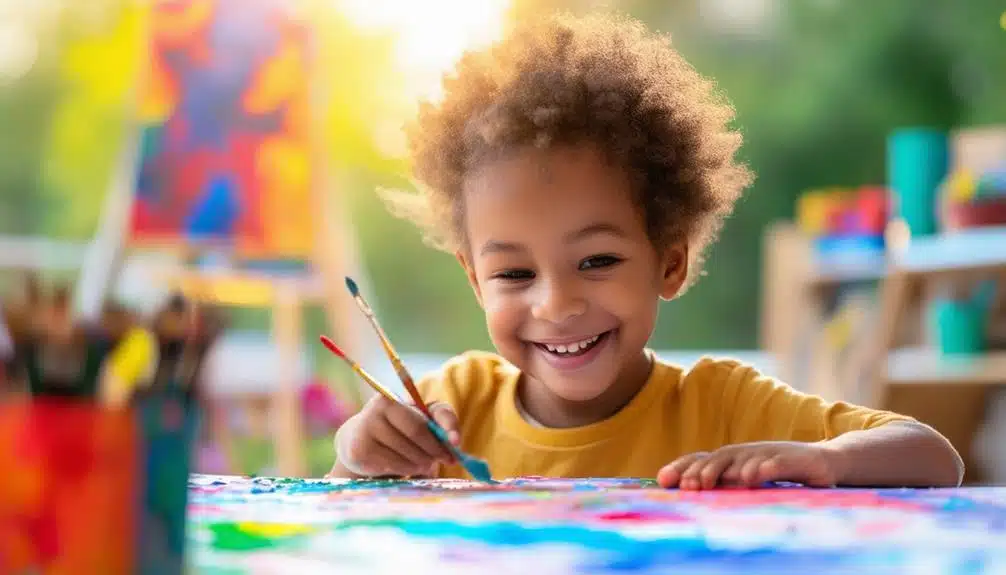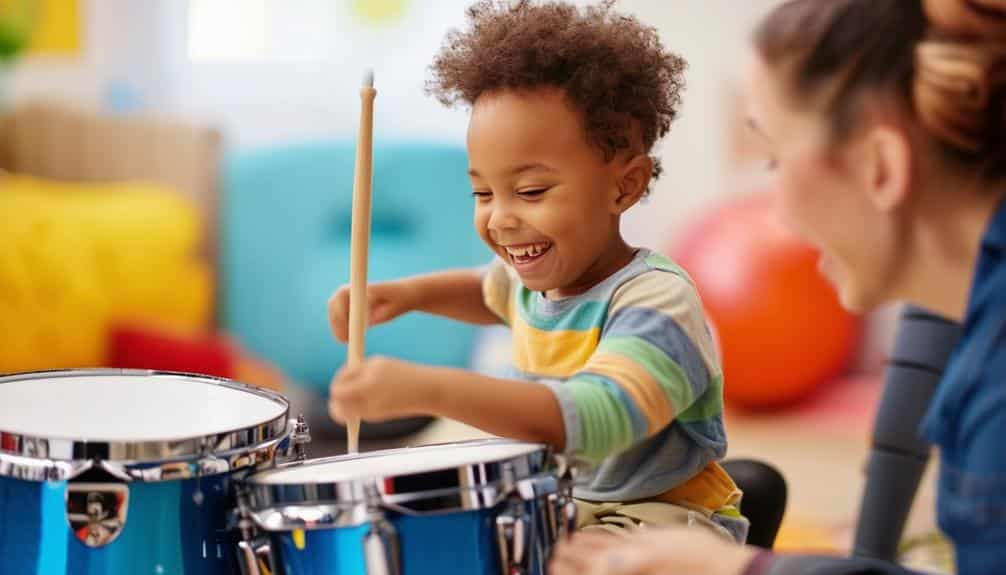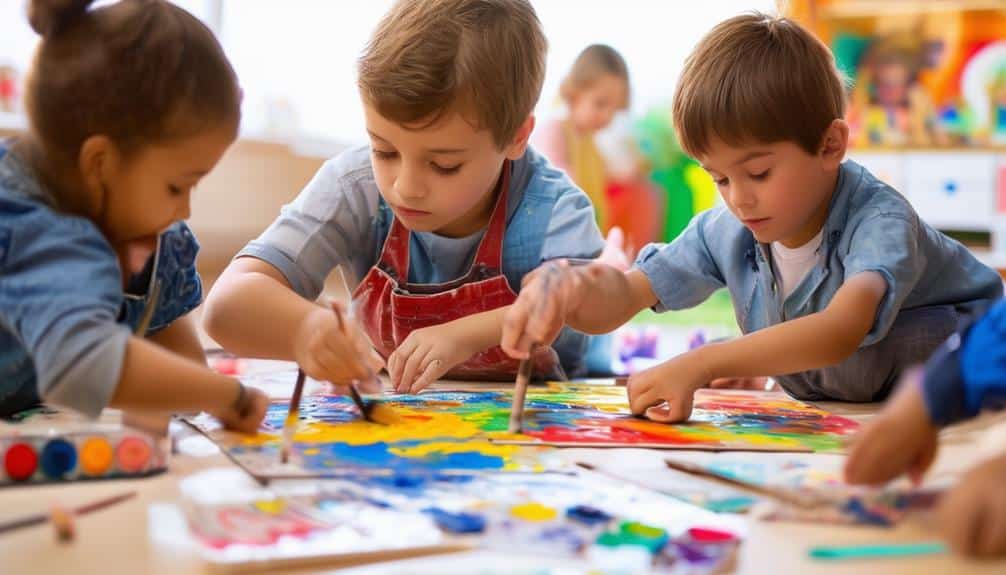Discover how Family-Friendly Autism Activities can boost communication and strengthen bonds between children with autism and their loved ones. From exciting video games to soothing music therapy, these activities provide fun and engaging ways for kids to connect with their caregivers and friends while developing essential skills.
Have you ever wondered how to get the most out of these activities? We are here to help! Explore twelve unique activities that can make a real difference in your child. Find out how these strategies can enhance relationships and support your child’s growth.
Key Takeaways
- Interactive video games enhance social skills and provide structured environments that foster understanding and bonding.
- Art therapy develops fine motor skills, cognitive planning, and communication through painting and crafting.
- Lego building encourages cognitive development and social skills like sharing and collaboration through problem-solving tasks.
- Cosplay in science fiction and fantasy offers a safe space for social skills development and creative engagement.
- Culinary activities enhance fine motor skills, foster teamwork, and create shared experiences, improving relationships with children with autism.
Understanding Autism and Relationships
Understanding autism and relationships involves uncovering the nuanced complexities of communication, social interaction, and behavior. It requires an empathetic approach, patience, and a readiness to learn about the specific needs of these special children. It is essential to realize how nonverbal cues, sensory sensitivities, and social norms can be challenging for autistic children. This foundational understanding of autism is pivotal in building relationships that can improve a child’s self-esteem, social skills, and overall well-being.
A significant aspect of achieving these positive relationships is social skills training. This involves teaching autistic children how to interpret nonverbal cues, manage sensory sensitivities, and understand social norms. An empathetic and patient approach is essential in this training, as each child’s experience is distinct.
Moreover, tailored activities that accommodate the strengths and preferences of autistic children are fundamental tools in relationship-building. These activities allow children to express themselves and engage in comfortable, rewarding interactions. By creating environments that cater to their needs, we can foster relationships that respect and accommodate the individual experiences of autistic children, promoting their social and emotional growth.
Incorporating Interactive Video Games
Incorporating interactive video games into the developmental journey of children with autism provides a unique and engaging platform to practice and enhance their social and communication skills. Video games offer a highly visual and structured environment, ideal for these children to learn and grow. Games like Minecraft, Pokémon, and Mario Bros, when played in two-player mode, foster social interaction, helping children connect social skills and enhance their perception of social cues.
Interactive video games also deliver instantaneous feedback, making them valuable tools for honing social skills. The immediacy of this feedback aids in comprehending the consequences of one’s actions, an essential element in developing social skills.
Furthermore, sharing the gaming experience can facilitate bonding opportunities. It allows for creating shared experiences, fostering understanding and empathy, and is a pivotal component in developing robust relationships.
Embracing the Power of Art Therapy

The power of art therapy in supporting children with autism is remarkable. It offers a unique, non-verbal medium for these children to express themselves creatively and understand their place in the world. Engaging in painting, crafting, and beading can improve their fine motor skills, concentration, and cognitive planning, fostering their overall development.
Expressing Through Art
While maneuvering the complexities of autistic children, art therapy emerges as a powerful tool that fosters communication, understanding, and coping mechanisms through creative expression. This form of treatment harnesses the power of art, enabling children to translate their thoughts and feelings into tangible creations. Art therapy fosters creative expression and cultivates fine motor skills and cognitive abilities.
The following techniques are commonly utilized in art therapy:
- Painting and Crafting: These activities stimulate fine motor skills and concentration, enhancing the child’s cognitive abilities.
- Feeling Exploration: Art therapy provides a safe, understanding platform for children to express their feelings and facilitates feeling exploration.
- Construction Projects: Building art pieces like clocks or engines can help develop planning and organizational skills.
- Interest-based Art: Encouraging children to create art around their interests channels their creativity into meaningful projects.
Art therapy represents a beacon of hope for children with autism, enabling them to express and understand themselves better while improving essential life skills.
Benefits of Art Therapy
Based on the activities involved, art therapy emerges as an empowering approach for children with autism. It has numerous benefits, ranging from enhanced communication skills to the development of cognitive abilities. This form of treatment employs creative expression as a medium, enabling these children to communicate their thoughts and feelings, often beyond the capacity of words.
Art therapy is a therapeutic outlet, providing a haven for emotional expression. Activities such as painting and crafting foster creativity and bolster fine motor skills, concentration, and planning abilities. For those with a fascination for mechanics, constructing devices like clocks renders an engaging avenue for cognitive and social skills development.
The beauty of art therapy lies in its adaptability. It can be tailored to personal preferences and strengths, offering an inclusive environment for children with autism. This flexibility makes it a potent tool in facilitating the development of a wide range of skills. Thus, art therapy’s benefits are beyond the art domain, contributing significantly to the holistic growth of autistic children.
Lego Building for Cognitive Development
In cognitive development, Lego building emerges as a potent tool that promotes problem-solving skills, spatial awareness, and creativity. It offers a hands-on approach for autistic children to enhance fine motor skills, attention to detail, and organizational abilities.
Lego building, an engaging and constructive activity, offers manifold benefits:
- It fosters cognitive development by enhancing problem-solving skills, spatial awareness, and creativity. As children meticulously piece together Lego blocks, they learn to visualize patterns and structures, boosting their spatial intelligence.
- Lego building promotes fine motor skills, attention to detail, and organizational abilities. The tactile nature of Lego blocks demands precision and careful handling, providing an excellent workout for fine motor skills.
- Through Lego building, children gain the confidence to follow steps and complete tasks, which is particularly beneficial for children with autism.
- Engaging in Lego-building activities also provides a structured and enjoyable way for children to develop social skills, such as sharing, turn-taking, and collaboration.
Through Lego building, we can foster an environment in which children with autism flourish cognitively, socially, and mentally.
Exploring Science Fiction and Fantasy

The domain of science fiction and fantasy presents an exceptional platform for children with autism to engage, connect, and express themselves creatively. There is an opportunity for mutual bonding, shared experiences, and nurturing social connections through cosplay, reading, and discussions around these genres. This exploration can enhance their imaginative skills and foster community, improving their relationships.
Engaging in Cosplay
Delving into the imaginative worlds of science fiction and fantasy through cosplay offers an enriching and enjoyable activity that can boost communication and social interaction for autistic children. This creative engagement in the sci-fi/fantasy universe encourages autistic children to express themselves while enhancing relationships and promoting social skills development.
Cosplay activities offer numerous benefits:
- Creativity and Skill Development: Designing costumes and props stimulates ingenuity and hones various skills, from design to sewing and painting.
- Social Interaction: Attending conventions and cosplay events provides opportunities for children to interact with their peers, learn about social cues, and practice communication.
- Shared Interests: Participating in a community with mutual interests can ease social anxieties and foster a sense of belonging.
- Enhanced Engagement: In-depth exploration of beloved characters and stories can lead to meaningful conversations and stronger bonds with family and friends.
The power of cosplay as a tool for social skills development should not be underestimated. It offers a safe space for autistic children to take on a different persona, explore emotions and relationships, and ultimately, learn to navigate social situations with increased confidence.
Reading and Discussion
Building on the benefits of cosplay, another enriching activity for children with autism involves exploring the worlds of science fiction and fantasy through reading and discussion. These genres, known for their rich, imaginative universes, are especially appealing to children on the spectrum, often providing a comfortable escape into captivating narratives that stimulate their distinct cognitive abilities.
Reading graphic novels or watching movies within these genres opens new avenues for communication and bonding experiences. Children can share their perspectives by discussing the intricate plotlines, characters, and favorite universes, enhancing their social skills and strengthening relationships with those around them.
In addition to reading and discussion, engaging in related activities can further enhance this experience. Activities such as costume-making or attending genre-specific events can foster meaningful connections, not only with the material but also with peers and family members.
Additionally, joining clubs or participating in cosplay related to science fiction and fantasy provides beneficial social experiences, further enhancing their sense of belonging. These activities offer autistic children an inclusive and engaging platform to express themselves, improve social interactions, and build stronger relationships.
The Therapeutic Influence of Trains
Many children with autism embrace the therapeutic influence of trains, finding solace and engagement in this structured and predictable interest. Train spotting provides a calming sanctuary for autistic children, offering a logical and engaging escape from a chaotic world.
- Train Spotting: Observing trains and noting their details is a logical and engaging activity that can captivate the interest of autistic children. It can provide a structured outlet for their energy and focus.
- Shows and Toys: Characters like Thomas the Tank Engine can become beloved figures. Playing with train sets can stimulate creativity while maintaining the comfort of predictability.
- Model Train Collecting: This hobby can lead to social opportunities like meet-ups and conventions. In these settings, children can practice their social skills in a supportive environment centered around their interests.
- Exploration and Bonding: Sharing the fascination with trains through videos and books can facilitate bonding between caregivers and children. This shared interest can provide a bridge for deeper personal connections.
Harnessing the therapeutic influence of trains can guide autistic children towards structured activities, enhance their social skills, and build stronger relationships.
Animal Care and Compassionate Bonding

Integrating animal care into the routine of children with autism offers many benefits, ranging from enhanced communication skills to increased empathy. The structured and rewarding nature of caring for pets reduces anxiety and provides a judgment-free and comforting presence for these children. By bonding with animals, children with autism can improve their social skills, gain confidence, and experience an overall enhancement in well-being.
Benefits of Pet Interaction
Research consistently shows the profound impact of pet interaction on children with autism, greatly enhancing their communication and social skills. The relationships formed with pets can be a transformative experience for these children, fostering a sense of connection, empathy, and responsibility.
Here are four key benefits that pet interaction provides:
- Improved Communication: Interacting with pets can encourage verbal communication and increase interaction in autistic children. The simplicity and predictability of pet behavior make it easier for them to interpret and respond.
- Enhanced Social Skills: Animals provide a safe, judgment-free space for children with autism to practice social interactions, improving their interpersonal relationships.
- Reduced Anxiety: A soothing pet presence can significantly decrease stress levels, offering comfort and companionship to children with autism.
- Development of Empathy: The responsibilities involved in caring for a pet can nurture empathy, resilience, and emotional regulation, providing a holistic approach to emotional growth.
Pet interaction is a powerful tool in improving the lives of children with autism, underscoring the importance of animal care and compassionate bonding in their developmental journey.
Fostering Animals Together
Many studies have demonstrated that nurturing animals collectively can be a remarkable tool in enhancing communication skills, cultivating empathy, and improving the overall well-being of children with autism. This form of animal therapy, where children are actively involved in the care of animals, provides an invaluable opportunity for social skill development in a relaxed and enjoyable environment.
Interacting with animals enhances social communication by offering a non-threatening medium for children to express and modulate their feelings. It aids in lowering stress levels while building relationships with the creatures they care for. The unconditional love and companionship of animals foster a strong bond, positively impacting the child’s ability to empathize with them. Moreover, the responsibility involved in caring for an animal can increase a child’s confidence and sense of accomplishment. Children learn essential life skills through regular care routines, further developing their social and communication abilities. Therefore, nurturing animals together forms a compassionate approach to therapy that can significantly enhance the quality of life for children with autism.
Storytelling and Language Skills Enhancement
Storytelling emerges as a powerful tool for enhancing language skills for children with autism. It can stimulate creativity, social interaction, and understanding of emotions, perspectives, and social cues. When employed effectively, storytelling can significantly enhance social skills and communication competencies in autistic children.
- Visual Aids: Utilizing visual aids such as picture books or props can make storytelling more engaging and understandable for autistic children, thereby boosting their interaction and understanding.
- Understanding Emotions: Through characters and plot, storytelling offers a platform to explore various emotions, helping children identify and express feelings safely.
- Developing Communication Skills: Co-creating stories fosters turn-taking, active listening, and expressive language, thereby honing communication skills.
- Enhancing Social Skills: Through storytelling, children learn to appreciate different perspectives, empathize with characters, and grasp social cues, significantly improving their social skills.
Storytelling is a rewarding method for fostering imagination, empathy, and connection. This tool can facilitate meaningful relationships and improved communication, making a significant difference in the lives of autistic children.
Improving Relationships Through Music Therapy

Shifting our focus to another effective method for improving relationships in children with autism, we find music therapy. This therapeutic approach harnesses the power of music to enhance social skills, communication, and the expression of feelings. When implemented thoughtfully, music therapy can reduce anxiety, improve mood, and enhance overall well-being in these distinct individuals.
Music therapy promotes sensory integration and motor coordination, critical elements that help children with autism better understand and interact with the world around them. This integrative approach offers a verbal avenue for self-expression, allowing children to connect and communicate creatively and meaningfully.
Incorporating music into daily routines can also establish a calming and structured environment. This sense of order can be particularly beneficial for children with autism, who often thrive in predictable settings. With its rhythmic patterns and melodies, music provides this structure while fostering a sense of joy and achievement.
Engaging in Physical Activities Together
Engaging in physical activities together provides a crucial chance to enhance the bond, communication, and trust between children with autism and their caregivers. These activities boost physical health and act as a platform for social interaction.
- Physical activities, like hiking, swimming, or playing sports, offer ample sensory play, meeting the needs of sensory-seeking autistic children. This sensory engagement can cultivate a better understanding of their surroundings, enhancing their cognition and communication skills.
- Regular physical activity can notably decrease stress and anxiety in children with autism. The endorphins released during such activities promote well-being and happiness, improving their mood and behavior.
- Participating in physical activities together promotes a sense of teamwork and cooperation. This not only helps in developing their social skills but also instills a sense of achievement and belonging.
- Shared experiences through physical activities strengthen the bond between caregivers and autistic children. Joy, laughter, and accomplishment create lasting memories, nurturing a deeper relational connection.
Incorporating physical activities into the daily routine of children with autism can, thus, significantly improve their relationships with their caregivers.
Cooking Activities for Skill Development

While physical activities offer numerous benefits, culinary activities are another effective method of fostering skill development and improving relationships in children with autism. These activities provide a structured, predictable environment that can be calming for children with autism, encouraging them to engage in tasks that can enhance their fine motor skills and sensory exploration.
Culinary activities also offer excellent opportunities for social interaction and the development of communication skills. As children with autism engage in these activities, they learn about teamwork, following instructions, and the sequential cooking process. This can significantly benefit their cognitive development and their ability to interact with others.
Moreover, culinary activities can be a joyous bonding experience between children with autism and their caregivers. As they create a meal together, they also create shared experiences and memories, which can significantly improve their relationship. Furthermore, these activities offer a platform for children to learn about nutrition, measurements, and sequencing, broadening their knowledge base.
Puzzles and Board Games Engagement
Integrating puzzles and board games into the daily routines of children with autism can significantly enhance their cognitive abilities, social interactions, and problem-solving skills. These engaging activities offer a fun, interactive way to improve various abilities while providing a structured environment that caters to the comfort and stability often required by autistic children.
- Improved Cognitive Abilities and Problem-Solving Skills: The nature of puzzles and board games encourages logical thinking and problem-solving, aiding in the development of cognitive functions in autistic children.
- Enhanced Social Skills: These activities promote interaction and cooperation, fostering improved social skills among autistic children.
- Better Communication and Turn-taking Skills: Games often require communication and turn-taking, two essential skills that can be challenging for children with autism. They provide a safe and fun platform for practice.
- Structured Environment: Puzzles and board games follow rules, providing a predictable and structured environment that children with autism may find comforting and more engaging.
Incorporating puzzles and board games into the daily routine is not just about play—it’s about equipping children with autism with the tools they need to navigate social interactions and understand the world around them better.
Frequently Asked Questions
How Do You Build Positive Relationships With an Autistic Child?
To build authentic connections with autistic children, show sincere care, respect their comfort zones, and prioritize their well-being. Accommodate their needs, value their strengths, and engage in activities that promote their social and heartfelt development.
What are some practical Family-Friendly Autism Activities?
Engaging in Family-Friendly Autism Activities like interactive video games, art therapy, and Lego building can significantly enhance communication and social skills for children with autism. These activities provide structured environments that foster meaningful interactions and build stronger family connections.
What Are Highly Structured Activities for Autism?
What if we could enhance autistic children’s learning through children’s ability? Highly structured activities, with clear routines and visual supports, offer this consistency, fostering improved communication, social skills, and overall well-being in an engaging, individualized manner.
What Is the Best Activity for an Autistic Child?
The best activity for a child with autism is highly tailored, depending on their interests and sensory preferences. It could range from art therapy and Lego play to structured play or community engagement activities.
How Do You Build a Relationship With a Student With Autism?
Building a relationship with a student with autism involves understanding their comfort zones, accommodating their needs, expressing faith in their abilities, and prioritizing their welfare through transparent decision-making and valuing their input.


Recent Comments